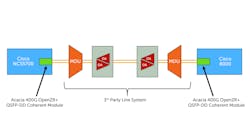Telia Carrier to adopt coherent pluggable transceivers for router interconnect
Telia Carrier says it plans to pursue and IP over DWDM (IPoDWDM) approach toward convergence of its IP and optical networking layers. The international communications services provider says it will begin pairing 400G coherent pluggable modules from Acacia Communications with Cisco’s NCS 5700 and 8000 routers to achieve this goal.
Cisco announced plans to purchase Acacia in 2019 (see “Cisco to buy Acacia Communications for optical transceiver, components play”).
Telia Carrier will combine the Acacia pluggable optics with open line systems elements and terminal elements that it has begun to deploy already. The Acacia QSFP-DD optical transceivers are capable of operating in 400ZR and ZR+ modes (see “Acacia offers range of 400-Gbps coherent optical modules” or watch “400G Module Update with Acacia Communications”). When fully deployed, the topology will support data rates from 100G to 400G; the choice of transmission rate may be reach dependent. The modules also will support client nx100GbE multiplexing as well as 400GbE transport.
"Conventional architectures and technologies built on decades of accumulated complexity and yesterday's truths fall short in helping us keep up with customer demands for more, consistent bandwidth and a high-quality experience,” commented Staffan Göjeryd, CEO at Telia Carrier. “Starting in the metro, standardized coherent pluggable modules are the next natural step in evolving cost structures, efficiency, and scaling capabilities. This follows our global deployments of open optical line-systems and bandwidth-optimized switch-router silicon already powering thousands of 400GbE-capable ports in the network."
Cisco has long championed IPoDWDM as an efficient means of connecting routers over fiber-optic networks (see, for example, "Cisco unveils IP-over-DWDM support for CRS-1 platform" from 2006). However, the concept didn’t gain significant traction until the advent of pluggable transceivers that enabled efficient 100G transport, initially for data center interconnect, without taking up a full router slot. With the topology’s acceptance growing, network operators have begun to consider its use in additional applications, with some observers suggesting that pluggable coherent optics could become a major factor in future network architectures (see “Cignal AI: Expect coherent pluggables wave to reshape networks”).
"Adding support for pluggable 400G optics directly into mass-scale routing platforms allows operators to converge historically complex infrastructure into a simple, single-layered architecture. The benefits – easier to maintain, faster to adapt, and cheaper to operate – are so compelling that we expect communication service providers to aggressively transition existing metro and long-haul networks to a Routed Optical Networking solution. This architecture can cost-effectively handle the projected traffic growth for the coming years while preparing to support the next transition to 800G or beyond," said Kevin Wollenweber, VP/GM Mass-scale Infrastructure Routing and Automation at Cisco.
For related articles, visit the Network Design Topic Center.
For more information on high-speed transmission systems and suppliers, visit the Lightwave Buyer’s Guide.
To stay abreast of fiber network deployments, subscribe to Lightwave’s Service Providers and Datacom/Data Center newsletters.
About the Author

Stephen Hardy
Editorial Director and Associate Publisher, Lightwave
Stephen Hardy is editorial director and associate publisher of Lightwave and Broadband Technology Report, part of the Lighting & Technology Group at Endeavor Business Media. Stephen is responsible for establishing and executing editorial strategy across the both brands’ websites, email newsletters, events, and other information products. He has covered the fiber-optics space for more than 20 years, and communications and technology for more than 35 years. During his tenure, Lightwave has received awards from Folio: and the American Society of Business Press Editors (ASBPE) for editorial excellence. Prior to joining Lightwave in 1997, Stephen worked for Telecommunications magazine and the Journal of Electronic Defense.
Stephen has moderated panels at numerous events, including the Optica Executive Forum, ECOC, and SCTE Cable-Tec Expo. He also is program director for the Lightwave Innovation Reviews and the Diamond Technology Reviews.
He has written numerous articles in all aspects of optical communications and fiber-optic networks, including fiber to the home (FTTH), PON, optical components, DWDM, fiber cables, packet optical transport, optical transceivers, lasers, fiber optic testing, and more.
You can connect with Stephen on LinkedIn as well as Twitter.
